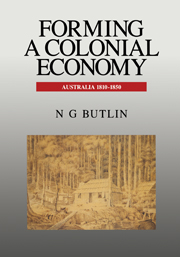Book contents
- Frontmatter
- Contents
- List of Tables
- List of Figures
- Acknowledgements
- Part I Forming an Economy
- Part II The Colonial Peopling of Australia: 1788–1850
- Part III Public Funding of Colonial Development: 1788–1850
- 5 Introduction
- 6 British Fiscal Characteristics
- 7 The Imperial Fisc in NSW and Van Diemen's Land to 1821
- 8 Broad Relations between British and Australian Fiscs to 1821
- 9 The Beginning of Local Budgeting: Real and Subterranean Budgets
- 10 The Conventional Legal Fisc in NSW: 1822–50
- Part IV The Colonial Australian Economy 1810–1840—A Historical, Statistical and Analytical Account
- Bibliography
- Appendixes
- Index
6 - British Fiscal Characteristics
from Part III - Public Funding of Colonial Development: 1788–1850
Published online by Cambridge University Press: 04 August 2010
- Frontmatter
- Contents
- List of Tables
- List of Figures
- Acknowledgements
- Part I Forming an Economy
- Part II The Colonial Peopling of Australia: 1788–1850
- Part III Public Funding of Colonial Development: 1788–1850
- 5 Introduction
- 6 British Fiscal Characteristics
- 7 The Imperial Fisc in NSW and Van Diemen's Land to 1821
- 8 Broad Relations between British and Australian Fiscs to 1821
- 9 The Beginning of Local Budgeting: Real and Subterranean Budgets
- 10 The Conventional Legal Fisc in NSW: 1822–50
- Part IV The Colonial Australian Economy 1810–1840—A Historical, Statistical and Analytical Account
- Bibliography
- Appendixes
- Index
Summary
On first encounter, the system of public finance established in New South Wales and Van Diemen's Land may seem a quaint colonial peculiarity. Some of its features, in the use of convicts as a fiscal mechanism, certainly were; so, too, were the special drawing rights of the governors on the British Treasury. But many other characteristics such as the lack of conscious processes of appropriations, the incoherence of public finance until the late 1820s, the dependence on fees in cash or kind to support officials, the privatisation of much of the public funds and the remarkable modes of accounting adopted were far from peculiar. They derived from British fiscal procedures of the second half of the 18th century.
The First Fleet sailed at a date almost centred between the beginning and end of a 17-year process of British fiscal reform between 1780 and 1797. The Fleet and the subsequent transfer of the NSW Corps in 1790 carried to NSW essentially pre-1780 fiscal attitudes of Britain, both at the civil and military level. That public finance in NSW became increasingly strange up to the end of the 1820s was partly due to the fact that British reforms were not communicated to the settlement. But, in addition, the British failed to establish fiscal control over the settlement and this made the local Australian approaches increasingly archaic and divergent.
- Type
- Chapter
- Information
- Forming a Colonial EconomyAustralia 1810–1850, pp. 57 - 60Publisher: Cambridge University PressPrint publication year: 1994



